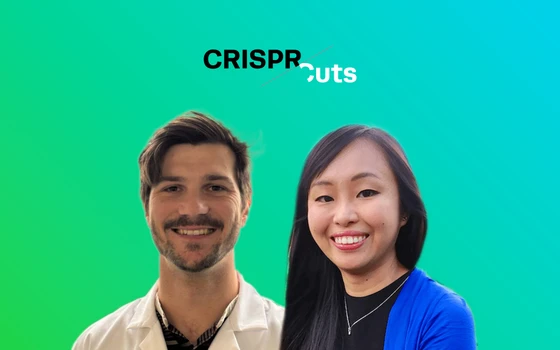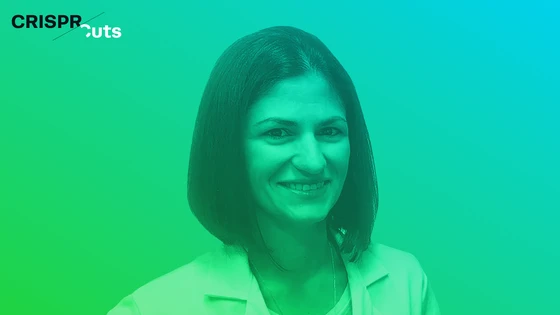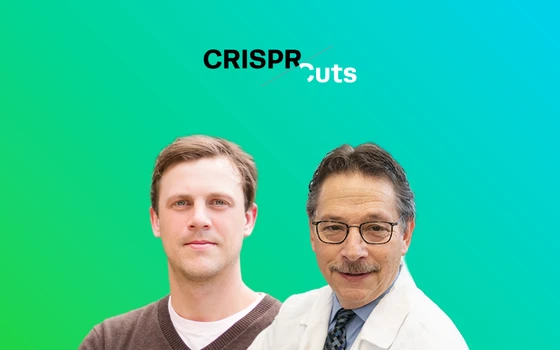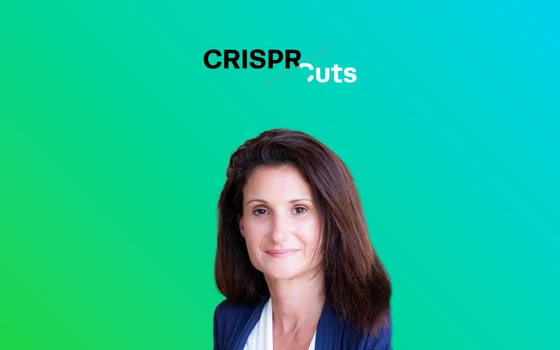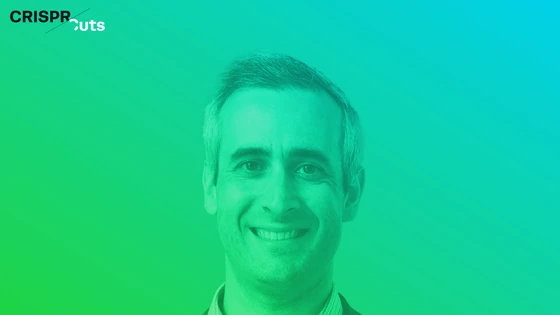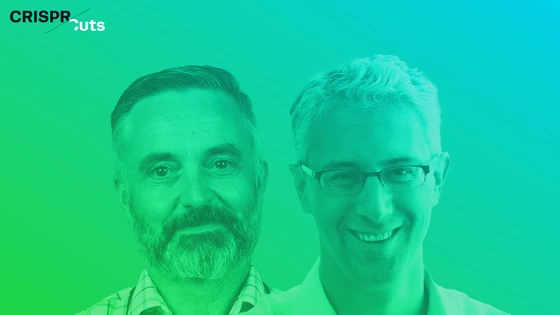Contents
In an exciting development for the CRISPR cell and gene therapy field, a CRISPR-based curative therapy for HIV has recently been given FDA approval to begin clinical trials. EBT-101 is the first CRISPR therapy targeting an integrated virus in humans, and it highlights the potential of CRISPR to cure infectious diseases with a single treatment.
To explore this fascinating topic in more detail, we spoke with TJ Cradick, the Chief Scientific Officer of Excision BioTherapeutics, the creators of EBT-101 therapy. In this blog, we discuss HIV infection and the need for a cure, TJ’s background in HIV research and gene-editing technology, how EBT-101 therapy works, and how Excision Bio is developing CRISPR cures for other viral infections.
HIV: Infection, Treatment Options, and the Need for a Cure
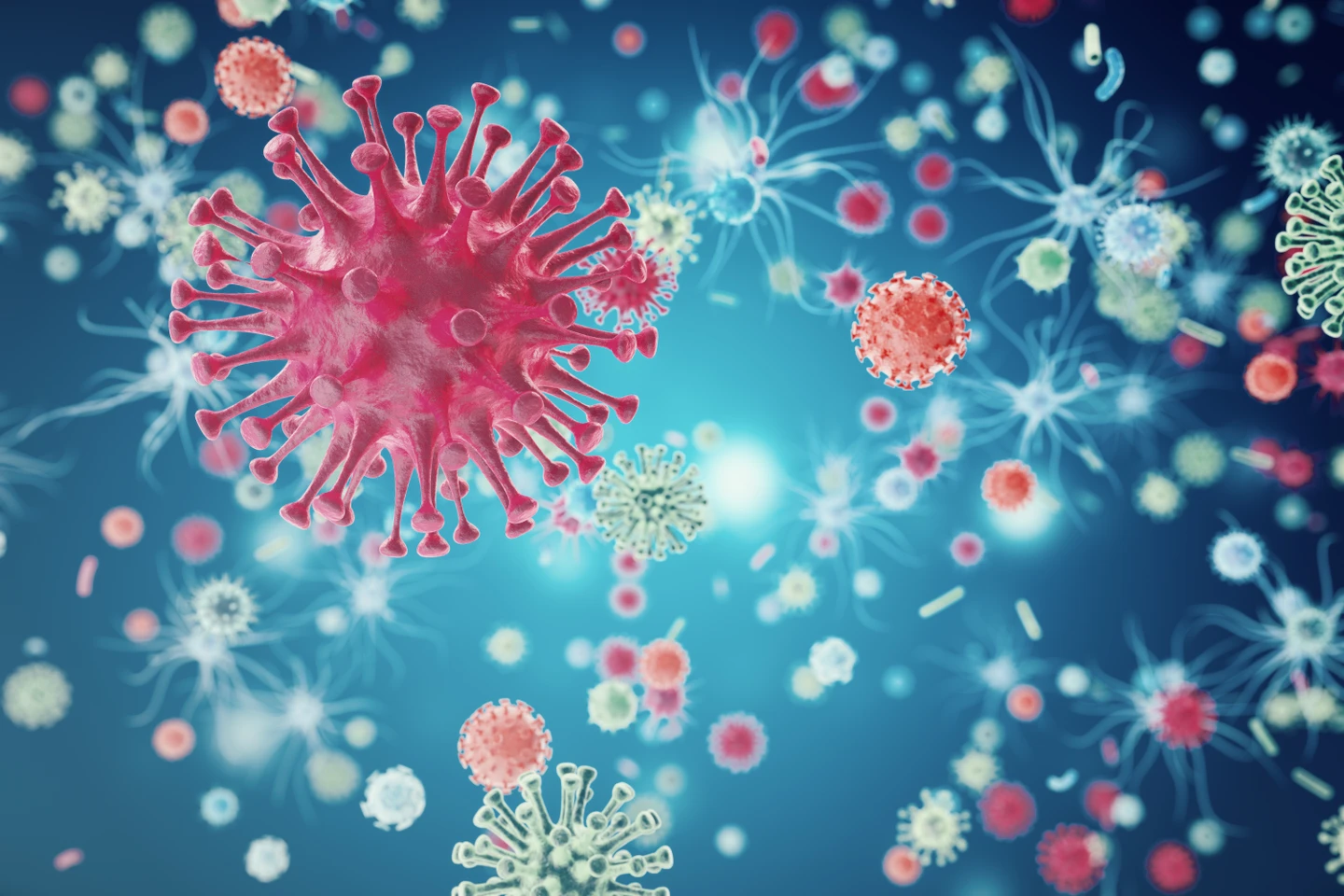
Human immunodeficiency virus (HIV) is a notorious pathogen for which there is currently no cure. HIV belongs to the retrovirus group—a unique subset of RNA viruses—and was first discovered in the early 1980s when the HIV epidemic began. Affecting 38 million individuals across the globe, HIV can cause acquired immunodeficiency syndrome (AIDS) if left untreated.
After exposure via bodily fluids, HIV infects human helper T lymphocytes (CD4+ T cells) by binding to the cluster of differentiation 4 (CD4) receptor and the chemokine co-receptor expressed on the cell surface. After gaining access to the host cell, HIV uses reverse transcriptase to create a complementary DNA strand of its RNA genome, which it then integrates into the host cell’s genome.
Integration of HIV into the host genome means that the host cell copies the virus alongside its own genetic material. When enough virions (viral particles) have accumulated in the host cell, it will burst open, allowing the new virions to escape and infect more CD4+ T cells, spreading throughout the host's body.
Helper T cells play a key role in the adaptive immune system by regulating and assisting other immune cells, including activating cytotoxic (killer) T cells and promoting the formation of antibodies by B cells. By infecting and destroying the helper T cells, HIV prevents the collective immune system from working properly and can lead to the development of AIDS. The disease manifests when CD4+ T cell counts are extremely low, and the immune system can no longer identify and fight off other pathogens and cancerous cells.
Antiretroviral therapies (ARTs) are currently used to treat HIV and prevent the onset of AIDS. There are several different types of ARTs, and they are often used in combination to achieve maximal results. These therapies typically prevent viral replication and can keep the number of viral copies in a patient’s bloodstream extremely low, allowing the immune system to function more normally and significantly reducing the risk of virus transmission.
Although ARTs are very effective, HIV integrates into the host genome and can hide in ‘dormant’ helper T cells for months or years without circulating in the bloodstream where ARTs can affect them. This means that even with daily, long-term ART, HIV cannot be entirely eliminated from the body. ARTs can also have various side effects and must be taken for life. Therefore, a one-time cure for HIV would be nothing short of groundbreaking, transforming the lives of millions of HIV patients.
Listen to the full interview with TJ Cradick about Excision Bio’s strategy to cure HIV with CRISPR technology here.
TJ Cradick: A Gene-Editing Pioneer
TJ Cradick is currently the CSO of Excision BioTherapeutics, a company that aims to develop CRISPR-based therapies to cure viral infections. TJ was always interested in maths and science as a child, and by high school, he was interested in becoming a biomedical engineer. Working on HIV is not a recent development for TJ - one of his first jobs out of college was at Repligen, where he characterized monoclonal antibodies against the virus. Later, while working at UCSF, he worked on deriving proteolytic antibodies against HIV.
TJ is also a genome-editing veteran, having watched the field develop throughout his scientific career. During his time at Sangamo Biosciences, he worked in the zinc finger nuclease (ZFN) design and selection group, then co-authored the first proof-of-concept publication using ZFNs - or any nuclease - to target a virus. He also helped develop a bioinformatic tool for nominating possible ZFN cleavage sites within genomes called ZFN-Site.
After some time working on ZFNs and transcription activator-like effector nucleases (TALENs) at Georgia Tech, TJ was an early adopter of the CRISPR-Cas9 system, co-authoring two of the first papers investigating the specificity of CRISPR editing. He also worked with CRISPR Therapeutics on therapeutics for hemoglobinopathies that are now in clinical trials. His current role allowed TJ to return to HIV research, using CRISPR-Cas9 to generate a cure.
EBT-101 Therapy for HIV
Excision Bio’s EBT-101 therapy recently received the go-ahead from the FDA to begin clinical trials. Using multiple single guide RNAs targeting different regions of the HIV genome, this strategy cuts the HIV DNA from the genome of human cells, eliminating the chance of viral escape. Importantly, there are very few sites where off-target editing could potentially occur, due to the targeting of viral DNA rather than human genes.
EBT-101 is delivered via an adeno-associated virus (AAV), specifically the serotype AAV9, which has broad tissue tropism. The therapy employs a Cas9 nuclease variant isolated from Staphylococcus aureus (SaCas9), which is smaller than the original Streptococcus pyogenes Cas9 (SpCas9) and is, therefore, more suitable for in vivo delivery with multiple sgRNAs. TJ explains more about how CRISPR can potentially cure HIV, the current clinical trial, and the long-term goals for EBT-101.
Kevin Bryant: What is it about the biology of HIV that lends itself to being targeted by CRISPR as a curative therapy?TJ Cradick: One interesting fact is that CRISPR was around well before gene editing – it evolved as an antiviral defense mechanism in bacteria. Therefore, it seems fitting that we are coming full circle, applying this natural antiviral system against human viral infections, including HIV.
Another key thing is that we can use multiple guide RNAs with CRISPR; one of the things that we've demonstrated is the efficacy of targeting using multiple guides. There's a chance to cut at each of the three target sites. And that allows excision of a thousand, or several thousand, nucleotides.
That is really an exciting part about this - the removal of these large segments of the HIV genome allows us, in a single treatment, to inactivate the virus and prevent the chance of viral escape.
TJ Cradick: One interesting fact is that CRISPR was around well before gene editing – it evolved as an antiviral defense mechanism in bacteria. Therefore, it seems fitting that we are coming full circle, applying this natural antiviral system against human viral infections, including HIV.
Another key thing is that we can use multiple guide RNAs with CRISPR; one of the things that we've demonstrated is the efficacy of targeting using multiple guides. There's a chance to cut at each of the three target sites. And that allows excision of a thousand, or several thousand, nucleotides.
That is really an exciting part about this - the removal of these large segments of the HIV genome allows us, in a single treatment, to inactivate the virus and prevent the chance of viral escape.
Minu Prabhune: You recently began a clinical trial of your EBT-101 therapy. Please tell us more about the trial.TJ: I think it's very exciting that we're now initiating enrollment for this landmark first-in-human phase I/II trial of EBT-101, and it's a potential cure for HIV infection. This is the first trial directly employing CRISPR as a potential curative regimen for latent viral infection.
There's certainly a growing interest in CRISPR. People are very interested in these technologies, particularly to target viruses. As a phase I/II study, we're looking at enrolling nine subjects with HIV infection and evaluating the safety by our distribution tolerability with a single treatment of EBT-101. After 48 weeks, all patients will be enrolled in a long-term follow-up protocol.
TJ: I think it's very exciting that we're now initiating enrollment for this landmark first-in-human phase I/II trial of EBT-101, and it's a potential cure for HIV infection. This is the first trial directly employing CRISPR as a potential curative regimen for latent viral infection.
There's certainly a growing interest in CRISPR. People are very interested in these technologies, particularly to target viruses. As a phase I/II study, we're looking at enrolling nine subjects with HIV infection and evaluating the safety by our distribution tolerability with a single treatment of EBT-101. After 48 weeks, all patients will be enrolled in a long-term follow-up protocol.
Kevin: Moving forward in the clinical trials, what kind of patients qualify to be treated with EBT-101 therapy?TJ: There are eligibility requirements, although they're fairly broad. One of the principal ones is that they have to be on sustained antiviral therapy before initiating EBT-101. So, we're excited that it seems to be a large number of patients will be eligible to enroll.
TJ: There are eligibility requirements, although they're fairly broad. One of the principal ones is that they have to be on sustained antiviral therapy before initiating EBT-101. So, we're excited that it seems to be a large number of patients will be eligible to enroll.
Minu: How long has this project been underway? Assuming it goes well, how long do you envision it will take before this therapy is approved by the FDA and becomes widely available?TJ: Excision Bio was founded in 2015 and this technology has been brewing within the company for quite a while. There are a number of publications from our collaborators in the Khalili Lab, and a range of others, demonstrating this concept of using multiple guides to target viruses. In this phase I/II trial, we're initially looking for safety and tolerability. There's the potential that we could see that in a short course, depending on how the patients progress.
TJ: Excision Bio was founded in 2015 and this technology has been brewing within the company for quite a while. There are a number of publications from our collaborators in the Khalili Lab, and a range of others, demonstrating this concept of using multiple guides to target viruses. In this phase I/II trial, we're initially looking for safety and tolerability. There's the potential that we could see that in a short course, depending on how the patients progress.
Kevin: Could you give any sort of estimated timelines when you might have some data to report on the EBT-101 trials? TJ: One of the key readouts is safety, and once the patients are coming in, we hope that there'll be no adverse events. We've done a lot of safety studies, and we’re hoping that those will be mirrored when we dose the patients. I probably can’t give a definitive date, but I think one of the things that is a bit different with this type of technology is that you've got the opportunity to see readouts fairly quickly.
TJ: One of the key readouts is safety, and once the patients are coming in, we hope that there'll be no adverse events. We've done a lot of safety studies, and we’re hoping that those will be mirrored when we dose the patients. I probably can’t give a definitive date, but I think one of the things that is a bit different with this type of technology is that you've got the opportunity to see readouts fairly quickly.
Minu: EBT-101 is one of the first therapies using CRISPR. Is it the technology that makes EBT-101 unique, or is it your approach? What has deterred others from attempting this before?TJ: I guess everything seems as though it's an exciting path forward once you're showing success. In the past, we targeted the virus with ZFNs and TALENs, but in those cases we generally used one pair, allowing a single cut site. With CRISPR, this ability to use two guides, which allow three cut sites, is what makes it unique.
Another unique aspect is that we've tested this on nonhuman primates (NHPs) and in humanized mice, so there are a number of different examples and experiments that we've done to prepare this to move toward this clinic.
For a more in-depth discussion of EBT-101 and the pre-clinical studies that enabled the trial, you can watch TJ’s full presentation at the Cell and Gene Therapy session of World CRISPR Day 2021.
TJ: I guess everything seems as though it's an exciting path forward once you're showing success. In the past, we targeted the virus with ZFNs and TALENs, but in those cases we generally used one pair, allowing a single cut site. With CRISPR, this ability to use two guides, which allow three cut sites, is what makes it unique.
Another unique aspect is that we've tested this on nonhuman primates (NHPs) and in humanized mice, so there are a number of different examples and experiments that we've done to prepare this to move toward this clinic.
For a more in-depth discussion of EBT-101 and the pre-clinical studies that enabled the trial, you can watch TJ’s full presentation at the Cell and Gene Therapy session of World CRISPR Day 2021.
Using CRISPR to Dismantle Other Pathogenic Viruses
In addition to his work on HIV, TJ is also overseeing many other projects which use CRISPR to generate cures for viral infections. These novel therapeutics include EBT-103 therapy for JC virus, a pathogen that can cause progressive multifocal leukoencephalopathy (PML), EBT-104 therapy for herpes simplex virus (HSV), and EBT-107 therapy for hepatitis B virus (HBV). TJ shares some insights on the exciting projects he’s working on at Excision, public perception of CRISPR cell and gene therapies, and the future of CRISPR medicines.
Kevin: You and your team are working on other viruses, like the Hepatitis B virus and HSV. Are you also developing some therapeutic strategies for these viruses? What makes certain viruses good candidates to be targeted by CRISPR?TJ: Yes, those are underway where we're co-developing projects for each of those viruses. Excision is all-in on targeting viruses and infectious diseases. We’re working with virologists, bioinformaticians, and the gene-editing team as we develop those strategies. I think improving technology is a very exciting part of that. We’re using different nucleases and developing new technologies and assays to move these projects forward. We're also working on projects to improve our ability to use multiple guides to effectively excise viral DNA.
The key part, of course, is that we're going after the DNA of an integrated virus. That’s what differentiates HIV from some other targets. I think that certainly from this EBT-101 clinical trial, we'll learn a lot that will help us with these other viral targets. That’s one of the things that’s great about our unified approach.
TJ: Yes, those are underway where we're co-developing projects for each of those viruses. Excision is all-in on targeting viruses and infectious diseases. We’re working with virologists, bioinformaticians, and the gene-editing team as we develop those strategies. I think improving technology is a very exciting part of that. We’re using different nucleases and developing new technologies and assays to move these projects forward. We're also working on projects to improve our ability to use multiple guides to effectively excise viral DNA.
The key part, of course, is that we're going after the DNA of an integrated virus. That’s what differentiates HIV from some other targets. I think that certainly from this EBT-101 clinical trial, we'll learn a lot that will help us with these other viral targets. That’s one of the things that’s great about our unified approach.
Kevin: How much does the cell type that the virus is latent in matter? In HSV for example, it's in the neurons; is it difficult to deliver the CRISPR Cas9 components to certain cells?TJ: Viruses are a bit different in where they're located in the body, and obviously we want to ensure that we'll target the viral stores. One of the questions we also get asked is whether we are specifically targeting only the cells with the virus. I think that's one of the reasons the lack of off-target cleavage in these cells is very exciting. When we go into cells without HIV, or if we've removed the HIV, then the cells lack the target - that's a critical aspect.
In terms of targeting the cells that have the virus, that is one of the reasons we've done the non-human primate studies to look at the biodistribution for the AAV. For other viruses, such as HPV, we have a range of different delivery options, so we are evaluating different ways of getting into the cells that are relevant for these future viral targets.
TJ: Viruses are a bit different in where they're located in the body, and obviously we want to ensure that we'll target the viral stores. One of the questions we also get asked is whether we are specifically targeting only the cells with the virus. I think that's one of the reasons the lack of off-target cleavage in these cells is very exciting. When we go into cells without HIV, or if we've removed the HIV, then the cells lack the target - that's a critical aspect.
In terms of targeting the cells that have the virus, that is one of the reasons we've done the non-human primate studies to look at the biodistribution for the AAV. For other viruses, such as HPV, we have a range of different delivery options, so we are evaluating different ways of getting into the cells that are relevant for these future viral targets.
Minu: Historically there have been some setbacks in terms of cell and gene therapies. How accepting are the public of these therapies today, and how can companies like Excision help people to understand the technology? TJ: We've certainly had a very enthusiastic response from members of the public. I believe that people are really excited to have the virus removed, even if there are some treatments that they're currently available. In terms of allowing people to understand it, we're excited about publishing, presenting at conferences, and putting our work into peer review. That enables everyone to see, for example, the safety package or the non-human primate data, and understand what we've done.
That means when people have questions, they can access all of those resources. When we've shown this information or gone to patient advocacy groups, they have been very excited, and they have looked at the papers and the supplemental figures. So, it’s a great audience to share our progress with, because they are very excited about it.
TJ: We've certainly had a very enthusiastic response from members of the public. I believe that people are really excited to have the virus removed, even if there are some treatments that they're currently available. In terms of allowing people to understand it, we're excited about publishing, presenting at conferences, and putting our work into peer review. That enables everyone to see, for example, the safety package or the non-human primate data, and understand what we've done.
That means when people have questions, they can access all of those resources. When we've shown this information or gone to patient advocacy groups, they have been very excited, and they have looked at the papers and the supplemental figures. So, it’s a great audience to share our progress with, because they are very excited about it.
Kevin: What’s the next big thing that really is exciting and motivating to you?TJ: I think it's really exciting that we're expanding our research efforts and we're building the team even further. We're getting more opportunities to do all the things I described earlier, develop the technology, and move each of the viral targeting programs forward.
One of the aspects that I'm enjoying is that we're a very collaborative company, so we hope to expand our sponsor research projects and collaborations with industry colleagues. That’s something I'm excited about - as we're going into the clinic, we're also continuing to move forward on each of these other projects.
TJ: I think it's really exciting that we're expanding our research efforts and we're building the team even further. We're getting more opportunities to do all the things I described earlier, develop the technology, and move each of the viral targeting programs forward.
One of the aspects that I'm enjoying is that we're a very collaborative company, so we hope to expand our sponsor research projects and collaborations with industry colleagues. That’s something I'm excited about - as we're going into the clinic, we're also continuing to move forward on each of these other projects.
Kevin: You're in a unique position because you've seen the gene-editing field from the beginning to where they are now, with the development of all these technologies. Could you briefly expand on how you think CRISPR is changing medicine, not only for HIV but for other infectious diseases? How do you perceive the potential of CRISPR in everyday medical treatment in the future?TJ: There are certainly examples of well-engineered ZFNs and TALENs having a role in therapeutics, plant editing research, and a range of other applications. With the advent of CRISPR, we've seen a huge increase in the number of labs working on developing new nucleases, developing new strategies, coming up with ways to increase homology-directed repair, and improving methods of delivery. I think that's what's really exciting.
In terms of the future, one can look at the number of labs that are now working on gene editing and gene editing delivery assays, bioinformatics, and aspects that will speed future therapies to the clinic. These will also allow us to go after different indications and different viruses.
I continue to be very excited when I hear about my friends and former colleagues at companies that are working on this because we can take advantage of these technologies to move our projects forward. It's hard to look too far in the future because every week there're more CRISPR papers where people have improved upon efficacy, specificity, and delivery – it’s very exciting.
We hope this blog helped you get up to speed with how CRISPR technology is being used to generate cures for pathogenic viruses like HIV. Subscribe to The Bench Blog to stay updated on all the latest progress in this rapidly expanding field!
TJ: There are certainly examples of well-engineered ZFNs and TALENs having a role in therapeutics, plant editing research, and a range of other applications. With the advent of CRISPR, we've seen a huge increase in the number of labs working on developing new nucleases, developing new strategies, coming up with ways to increase homology-directed repair, and improving methods of delivery. I think that's what's really exciting.
In terms of the future, one can look at the number of labs that are now working on gene editing and gene editing delivery assays, bioinformatics, and aspects that will speed future therapies to the clinic. These will also allow us to go after different indications and different viruses.
I continue to be very excited when I hear about my friends and former colleagues at companies that are working on this because we can take advantage of these technologies to move our projects forward. It's hard to look too far in the future because every week there're more CRISPR papers where people have improved upon efficacy, specificity, and delivery – it’s very exciting.
We hope this blog helped you get up to speed with how CRISPR technology is being used to generate cures for pathogenic viruses like HIV. Subscribe to The Bench Blog to stay updated on all the latest progress in this rapidly expanding field!

